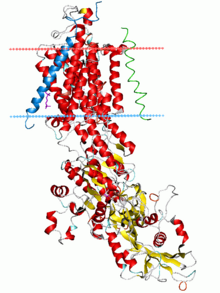Sodium potassium pump
| Na+/K+ ATPase pump | |||||||||
|---|---|---|---|---|---|---|---|---|---|

Sodium-potassium pump, E2-Pi state. Calculated hydrocarbon boundaries of the lipid bilayer are shown as blue (intracellular) and red (extracellular) planes
|
|||||||||
| Identifiers | |||||||||
| EC number | 3.6.3.9 | ||||||||
| Databases | |||||||||
| IntEnz | IntEnz view | ||||||||
| BRENDA | BRENDA entry | ||||||||
| ExPASy | NiceZyme view | ||||||||
| KEGG | KEGG entry | ||||||||
| MetaCyc | metabolic pathway | ||||||||
| PRIAM | profile | ||||||||
| PDB structures | RCSB PDB PDBe PDBsum | ||||||||
|
|||||||||
| Search | |
|---|---|
| PMC | articles |
| PubMed | articles |
| NCBI | proteins |
Na+
/K+
-ATPase (sodium-potassium adenosine triphosphatase, also known as the Na+
/K+
pump or sodium-potassium pump) is an enzyme (EC 3.6.3.9) (an electrogenic transmembrane ATPase) found in the plasma membrane of all animal cells. The Na+
/K+
-ATPase enzyme is a solute pump that pumps sodium out of cells while pumping potassium into cells, both against their concentration gradients. This pumping is active (i.e. it uses energy from ATP) and is important for cell physiology. An example application is nerve conduction.
It has antiporter-like activity, but since it moves both molecules against their concentration gradients it is not a true antiporter, which would require one solute to move with its gradient, not against it.
The sodium pump is a membrane protein that use energy in the form of adenosine triphosphate to perform active transport of sodium ions out of the cell in exchange for potassium ions into the cell. For every adenosine triphosphate molecule that the pump use, three sodium ions are exported, while two potassium are imported; there is hence a net export of a single positive charge per pump cycle. All mammals have four different sodium pump sub-types, or isoforms, that each has unique properties and tissue expression patterns.
...
Wikipedia
